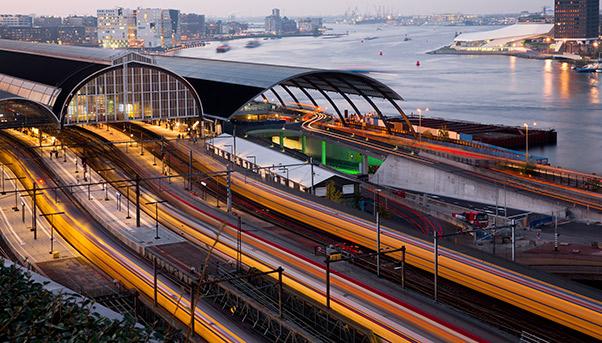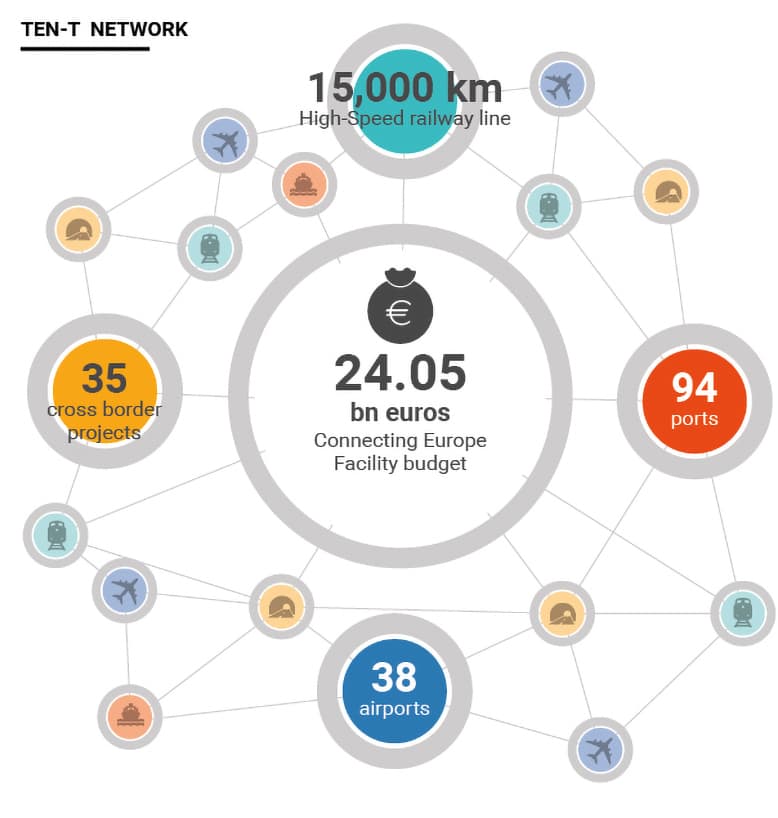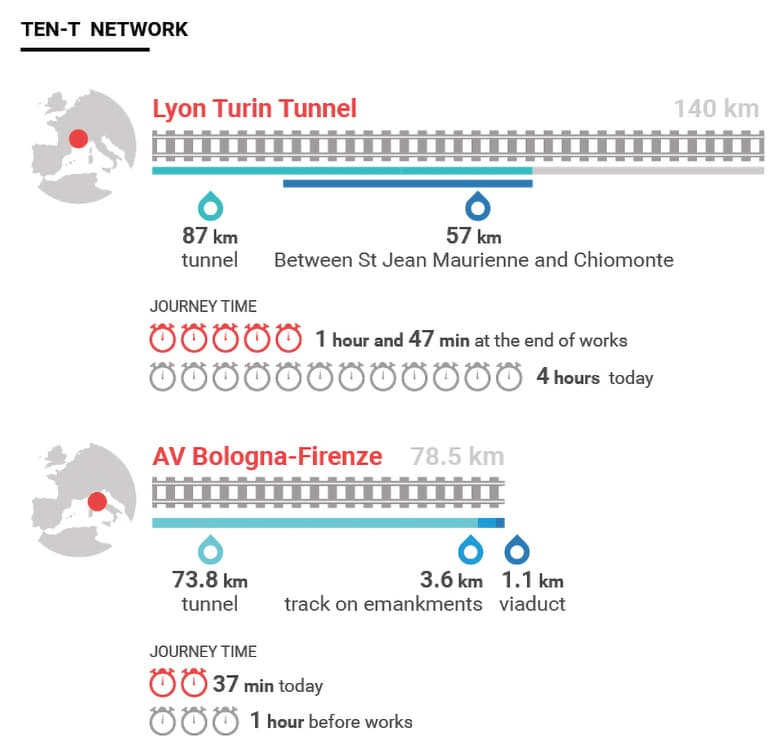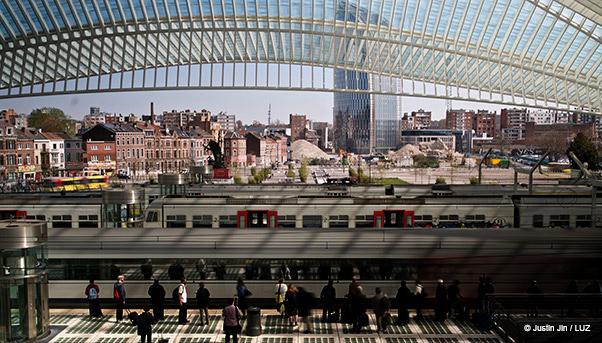
When you look at two parallel lines of track stretching towards the horizon, you understand that it’s much more than steel, concrete and stones. Railways are giving shape to a new Europe: where we live, work and relax has been determined by the growth of the rail network. With new high-speed links springing up from the Arctic Circle to the Mediterranean Sea, Europe is experiencing a new age of the train.
The Trans-European Transport Network: a Grand Project for Europe
In January 2014, the European Union (EU) set out a new transport infrastructure plan to help the region’s economy not only recover but flourish. A budget of €24.05 billion up until 2020 has been made available by the Connecting Europe Facility (CEF). It aims to connect the continent from East to West, North to South by relying on core network corridors to form the strategic heart of the trans-European transport network, known as TEN-T.

The corridors bring together rail, road, air, waterways, and freight hubs across the continent, with a core network consisting of 94 main European ports with rail and road links, 38 key airports with rail connections into major cities, and 35 cross border projects to reduce bottlenecks. On top of this, 15,000 kilometres of railway line will be upgraded to high speed. To put that in perspective, the 28 EU member states have 215,298 kilometres of railway lines in use, of which 115,734 were electrified at the end of 2013. At the end of 2014, there were 7,316 kilometres of high-speed lines in the bloc.
The impact of the TEN-T will be enormous, not only in terms of mobility but also employment. Implementing TEN-T could create up to 10 million jobs and increase Europe’s gross domestic product (GDP) by 1.8% by 2030, according to the European Commission. This is coming at a time when European citizens appear to be more willing to travel by rail. Between 2013 and 2014, its use reached 6.4 billion passenger-kilometres, a 1.5% increase (a passenger kilometre is the unit of measurement representing the transport of one passenger by a particular type of transport over one kilometre). The biggest increases were in Estonia, Romania and Ireland, up 27%, 14.2% and 8.1%, respectively.
The Role of the European Commission
In 2015, in addition to the TEN-T, European Commission set out a range of infrastructure projects to be funded by CEF. There will be a €13.1 billion investment plan in 276 transport projects, including the Brenner Base Tunnel between Austria and Italy, France’s Seine-Escaut waterway and the Iron Rhine rail line. The EU money is just the start of the investment process: the funds will unlock additional public and private co-financing for a combined amount of €28.8 billion.
Sustainable Transportation
The development of the railway system will generate real benefits for Europe in terms of mobility, connecting people to job opportunities as well as friends and family. Trains, which are powered by electricity, are more environmentally friendly than trucks and planes that use fossil fuels. Rail expert Mark Smith put together various statistics for his site, the Man in Seat 61, including Eurostar-commissioned independent research into the environmental impact of train travel. The reduction in carbon dioxide emissions per passenger produced by taking the train instead of the plane can be as much as 90%.
Better links also mean a stronger economy. «The Trans-European Transport Network is crucial for a Union striving for more growth, jobs and competitiveness“, EU Commissioner for Transport Violeta Bulc said earlier this year. “As Europe is slowly stepping out of the economic crisis, we need a connected Union, without barriers, in order for our single market to thrive».
Transporting Goods
Modernizing the continent’s railway network will also have an effect on the transport sector and the movement of goods. Every year, billions of tonnes of freight are transported across Europe – 74.8% of it by road. In an effort to get more freight moving by rail, large loads could be moved via high-speed trains like France’s TGV – with the EURO CAREX Cargo Rail Express Project. So the TEN-T project also foresees the use of this network of high-speed routes, including tunnels, to link up with freight terminals at European air and sea ports and continue the journey at high speed. Each 20-carriage train can be loaded and unloaded in 15 minutes – and transport over 100 tonnes.
Italian Works
Work has yet to start on Baltic railways, but another part of the TEN-T plan is complete. The Bologna-Florence high-speed railway, operating since 2009, is part of a wider TEN-T corridor, which connects Berlin and Palermo. Running since 2009, passenger trains take 37 minutes over the route compared to around an hour the old way. The line is 78.5 kilometres long and includes 73.8 kilometres of tunnels, 3.6 kilometres of track on embankments and 1.1 kilometres on viaduct. This huge undertaking was completed by Salini Impregilo, and is just one of many rail projects which will forge new high-speed networks taking Europe into a better-connected, greener future. Another on-going project by Salini Impregilo is the Terzo Valico dei Giovi (AV/AC) which connects Genoa to Milan and Turin and other European networks.

The Bologna-Florence connection, the Turin-Lyon route under the Alps, the Baltic railways and the Terzo Valico dei Giovi are all part of the various corridors set out under TEN-T, the bold new plan to connect sought by Italy to develop the continent. «With this new approach, we aim to join East and West and all corners of a vast geographical area“, EU Commissioner Siim Kallas said in 2014. «Railways are a key part of the network that we plan to build».
The Trans-European Transport Network: the Turin-Lyon
Lyon, France, and Turin, Italy, are both major business cities, but the journey between them takes nearly four hours: the obstacle is the Alps, which lie between these two industrial centres. French and Italian leaders have signed an agreement to build a 140-kilometre line, which will boast 87 kilometres of tunnels, including a 57-kilometre tunnel between Saint Jean de Maurienne, France, and Chiomonte in Italy. The project is called TELT (Euralpine Tunnel Lyon-Turin) and belongs to the TEN-T. Work is due to begin in 2017, with the line expected to open in 2028 or 2029, reducing the Lyon–Turin journey time to less than two hours.
Trains in History and Literature
«I never travel without my diary», wrote Oscar Wilde in The Importance of Being Earnest. «One should always have something sensational to read in the train». He wrote his play at a time when the railways were establishing the British seaside as a fashionable place to holiday, and opening up the world beyond to London. The Great Western Railway started operating in 1838 to transport millions of holiday-makers to the south coast, and it continues to do it to this day.
The United Kingdom is the birthplace of the railway: the Rocket was designed by Robert Stephenson in 1829, in Newcastle upon Tyne. It wasn’t the first steam engine, but the refined design made it the template for most steam engines in the following 150 years. The first railway line in continental Europe, between the cities of Brussels and Mechelen, opened in 1835. To this day, Belgium has one of the densest rail networks in the world.

As the 19th century progressed, adventurous, wealthy travellers explored new horizons. Phileas Fogg, the protagonist in the 1873 Jules Verne novel Around the World in Eighty Days, begins his circumnavigation of the globe by travelling from London to Brindisi by train. His adventures were no more fanciful than some real-life travel stories of the day: the King of Bulgaria once insisted that he should be allowed to drive the Orient Express through his country. The monarch, who was a fan of all things fast, cranked the speed up to maximum while the two drivers watched in horror. The Orient Express isn’t the only legendary train to capture writers’ imagination «Life is like a train, Mademoiselle. It goes on. And it is a good thing that that is so», Belgian detective Hercule Poirot said in The Mystery of the Blue Train by Agatha Christie. The Train Bleu was a luxury night train which connected Calais, Paris and the French Riviera.
Although fewer night trains run Europe-wide since the advent of cheap flights and high-speed rail, those that do retain their allure: since 2010, Russian Railways has run a regular service from Nice to Moscow, offering VIP sleeper cabins. The 3,483-kilometre journey takes 50 hours. As romantic as night trains are, they miss out on one thing: the scenery. The pleasure of watching the world go by through a train window has been documented by poets, philosophers and photographers. Europe’s most beautiful routes take in mountain and coastal scenery – meaning they were frequently the most challenging to build. The Bernina Express crosses the Swiss Alps, winding through vistas so breathtakingly beautiful they have been classified as a UNESCO World heritage site. Behind the views is a formidable feat of engineering: the track through the Albula and Bernina Passes involves 55 tunnels, 196 bridges and steep inclines in order to climb to a height of 2,253 metres above sea level.
Whether it’s building new routes through urban areas to connect our cities better, or spectacular bridges, tunnels and stations to provide faster journeys, Europe’s railways are getting a major makeover. There’s never been a better time to take the train.

